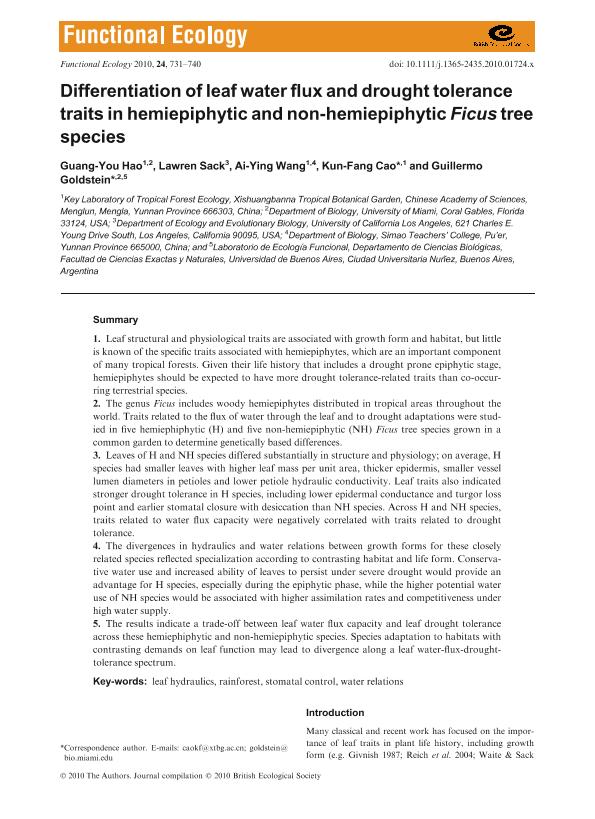Mostrar el registro sencillo del ítem
dc.contributor.author
Hao, Guang You
dc.contributor.author
Sack, Lawren
dc.contributor.author
Wang, Ai Ying
dc.contributor.author
Cao, Kun Fang
dc.contributor.author
Goldstein, Guillermo Hernan

dc.date.available
2019-01-25T20:38:44Z
dc.date.issued
2010-08
dc.identifier.citation
Hao, Guang You; Sack, Lawren; Wang, Ai Ying; Cao, Kun Fang; Goldstein, Guillermo Hernan; Differentiation of leaf water flux and drought tolerance traits in hemiepiphytic and non-hemiepiphytic Ficus tree species; Wiley Blackwell Publishing, Inc; Functional Ecology; 24; 4; 8-2010; 731-740
dc.identifier.issn
0269-8463
dc.identifier.uri
http://hdl.handle.net/11336/68673
dc.description.abstract
1. Leaf structural and physiological traits are associated with growth form and habitat, but little is known of the specific traits associated with hemiepiphytes, which are an important component of many tropical forests. Given their life history that includes a drought prone epiphytic stage, hemiepiphytes should be expected to have more drought tolerance-related traits than co-occurring terrestrial species. 2. The genus Ficus includes woody hemiepiphytes distributed in tropical areas throughout the world. Traits related to the flux of water through the leaf and to drought adaptations were studied in five hemiephiphytic (H) and five non-hemiepiphytic (NH) Ficus tree species grown in a common garden to determine genetically based differences. 3. Leaves of H and NH species differed substantially in structure and physiology; on average, H species had smaller leaves with higher leaf mass per unit area, thicker epidermis, smaller vessel lumen diameters in petioles and lower petiole hydraulic conductivity. Leaf traits also indicated stronger drought tolerance in H species, including lower epidermal conductance and turgor loss point and earlier stomatal closure with desiccation than NH species. Across H and NH species, traits related to water flux capacity were negatively correlated with traits related to drought tolerance. 4. The divergences in hydraulics and water relations between growth forms for these closely related species reflected specialization according to contrasting habitat and life form. Conservative water use and increased ability of leaves to persist under severe drought would provide an advantage for H species, especially during the epiphytic phase, while the higher potential water use of NH species would be associated with higher assimilation rates and competitiveness under high water supply. 5. The results indicate a trade-off between leaf water flux capacity and leaf drought tolerance across these hemiephiphytic and non-hemiepiphytic species. Species adaptation to habitats with contrasting demands on leaf function may lead to divergence along a leaf water-flux-drought-tolerance spectrum. © 2010 The Authors. Journal compilation © 2010 British Ecological Society.
dc.format
application/pdf
dc.language.iso
eng
dc.publisher
Wiley Blackwell Publishing, Inc

dc.rights
info:eu-repo/semantics/openAccess
dc.rights.uri
https://creativecommons.org/licenses/by-nc-sa/2.5/ar/
dc.subject
Leaf Hydraulics
dc.subject
Rainforest
dc.subject
Stomatal Control
dc.subject
Water Relations
dc.subject.classification
Otras Ciencias Biológicas

dc.subject.classification
Ciencias Biológicas

dc.subject.classification
CIENCIAS NATURALES Y EXACTAS

dc.title
Differentiation of leaf water flux and drought tolerance traits in hemiepiphytic and non-hemiepiphytic Ficus tree species
dc.type
info:eu-repo/semantics/article
dc.type
info:ar-repo/semantics/artículo
dc.type
info:eu-repo/semantics/publishedVersion
dc.date.updated
2019-01-25T13:39:20Z
dc.journal.volume
24
dc.journal.number
4
dc.journal.pagination
731-740
dc.journal.pais
Reino Unido

dc.journal.ciudad
Londres
dc.description.fil
Fil: Hao, Guang You. Chinese Academy of Sciences; República de China. University of Miami; Estados Unidos
dc.description.fil
Fil: Sack, Lawren. University of California at Los Angeles; Estados Unidos
dc.description.fil
Fil: Wang, Ai Ying. Chinese Academy of Sciences; República de China. Simao Teachers’ College; China
dc.description.fil
Fil: Cao, Kun Fang. Chinese Academy of Sciences; República de China
dc.description.fil
Fil: Goldstein, Guillermo Hernan. Consejo Nacional de Investigaciones Científicas y Técnicas. Oficina de Coordinación Administrativa Ciudad Universitaria. Instituto de Ecología, Genética y Evolución de Buenos Aires. Universidad de Buenos Aires. Facultad de Ciencias Exactas y Naturales. Instituto de Ecología, Genética y Evolución de Buenos Aires; Argentina. University of Miami; Estados Unidos. Universidad de Buenos Aires. Facultad de Ciencias Exactas y Naturales. Departamento de Ecología, Genética y Evolución. Laboratorio de Ecología Funcional; Argentina
dc.journal.title
Functional Ecology

dc.relation.alternativeid
info:eu-repo/semantics/altIdentifier/doi/http://dx.doi.org/10.1111/j.1365-2435.2010.01724.x
dc.relation.alternativeid
info:eu-repo/semantics/altIdentifier/url/https://besjournals.onlinelibrary.wiley.com/doi/full/10.1111/j.1365-2435.2010.01724.x
Archivos asociados
